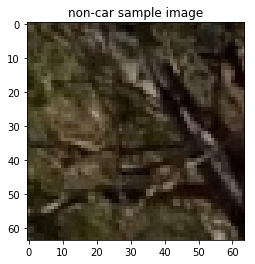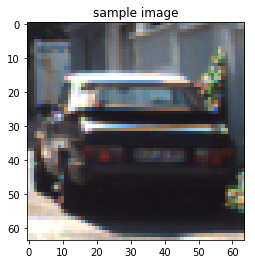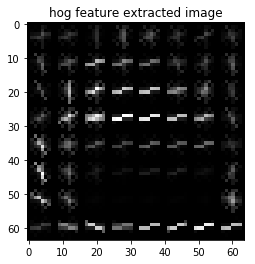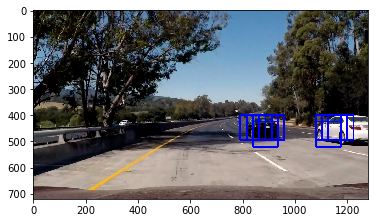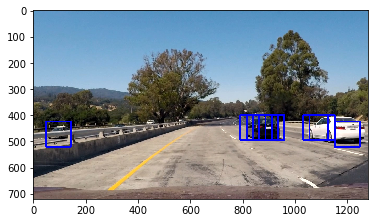Vehicle Detection Project
The goals / steps of this project are the following:
- Perform a Histogram of Oriented Gradients (HOG) feature extraction on a labeled training set of images and train a classifier Linear SVM classifier
- Implement a sliding-window technique and use the trained classifier to search for vehicles in the images.
- Run the pipeline on a video stream (test on test_video.mp4 and later implement on full video project_video.mp4) and create a heat map of recurring detections frame by frame to reject outliers and follow detected vehicles.
- Estimate a bounding box for vehicles detected.
The code for this step is contained in the code cell number 6 of the IPython notebook.
I started by reading in all the vehicle and non-vehicle images. Here is an example of one of each of the vehicle and non-vehicle classes:
I then explored different color spaces and different get_hog_features() parameters (orientations, pixels_per_cell, and cells_per_block). I grabbed random images from each of the two classes and displayed them to get a feel for what the get_hog_features() output looks like.
Here is an example from cars group using the RGB color space and HOG parameters of orientations=9, pixels_per_cell=(8, 8) and cells_per_block=(2, 2):
I tried various combinations of parameters and I came back to 9 orientations, 8 pixels per cell and 2 cells per block for my final implementation.
I trained a linear SVM using all the three feature sets of each image, i.e. Hog features, color histogram features, and spacial binning features. I chose the YCrCb color space because RGB gave me more false positives during my trials with the sample images.
The function find_cars in code cell number 16 includes the sliding window search algorithm. This code steps through the image in both horizontal and vertical directions. The image scale selected (1.5) is sufficient for image recognition.
Ultimately I searched on two scales using YCrCb 3-channel HOG features plus spatially binned and histograms of color in the feature vector, which provided a nice result. Here are some example images:
Here's a link to my video result
I recorded the positions of positive detections in each frame of the video. From the positive detections I created a heatmap and then thresholded that map to identify vehicle positions. I then used scipy.ndimage.measurements.label() to identify individual local peaks in the heatmap. I then assumed each blob corresponded to a vehicle. I constructed bounding boxes to cover the area of each blob detected.
The choice of threshold for the heatmap decided the false positives. I chose a threshold of 2 for the heatmaps for reasonable accuracy of detection. But this also means that in some of the frames the car does not get detected, simply because it was not crossing the threshold detection from multiple scales of the image detection algorithm.
However, the choice of parameters resulted in a reasonably working pipeline.
This project had taken the most time for me, simply because I was trying to run the models with lowest possible data, i.e. with only one channel or hog features, and nothing else. My experiments with every possible color space had some errors on the final video output. I was trying to run the pipeline from my PC.
I then moved the pipeline execution to AWS instance and increased the feature list, 3 channel hog features, and color histogram, spacial bins. It was not difficult to get it working at this point of time. I had to tune some hyperparameters to get it up and working.
Overall, this project has been an exhausting exercise, more intensive than the behavioural cloning project, and taught me a valuable lesson that more training data results in better model. But at the same time, this pipeline runs very slowly. This is not really optimized for real-time runs.

